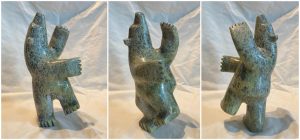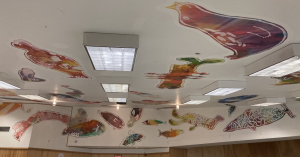 By Sarah Nixon
By Sarah Nixon
The views expressed in this blog are my own.
Kinngait is a community of about 1400 people just off the coast of Baffin Island in Nunavut, Canada. The region has been inhabited by Inuit for thousands of years. Its Inuktitut name means “where the mountains are” (or the hills, depending who you ask). Today, it’s known by many for the beautiful serpentine and soapstone carvings that artists have been making there for many generations.

During my internship with Nunavut Legal Aid, I was lucky to be given the opportunity to travel on circuit court to Kinngait. Circuit court is a process used to administer law in Nunavut to communities that do not have their own courthouses, resident lawyers, judges, and other courtworkers. To facilitate the application of Canadian law, then, a ‘court party’ comprised of defence lawyers, Crown prosecutors, courtworkers, a judge, a translator, a transcriptionist and a sheriff travel together to these communities periodically throughout the year to hold court. The frequency of ‘circuits’ depends on the particular community’s size and rate of criminalization. In the case of Kinngait, court is held for one week about five times per year.
However, due to COVID-19 pandemic restrictions, the circuit I attended in August 2021 was the first in-person circuit held in Kinngait in nearly five months. This is the first reason why this particular circuit was one of the busiest that had ever been held. The second reason is that Kinngait has been, for some time now, the most heavily criminalized community in Nunavut based on the proportion of its residents subject to criminal charges. The underlying causes for this reality are not clear to anyone, so far as I could tell during my time there. However, longstanding animosity between many of the local people and the Royal Canadian Mounted Police members stationed in the community may play a role in the rate of criminal charges being laid.
During circuit, the court party uses local buildings built for other purposes for client meetings and the court process itself. In Kinngait, we used the local Sewing Centre – a space for primarily women to gather and sew together – for client meetings on the weekend prior to the upcoming week of court. Using this space for our purposes meant that many client meetings were conducted in the furnace room to gain the necessary privacy required to discuss clients’ legal matters. Needless to say, sitting in on these meetings was somewhat of a surreal experience, with a noisy, hot furnace churning away between my supervising lawyer and her clients as they discussed their matters.
From Monday to Friday, we set up in the local community centre to hold court. The centre had recently been painted by a group of young people from the community with the help of an artist from the south. The setting was inherently less formal than courthouses I had visited in Montreal, Ottawa and Iqaluit. At the same time, the consequences of the court process were just as severe, with many witnesses, accused, and community members being retraumatized by the criminal process, and many individuals being sent into custody or receiving conditional sentence orders (the rough equivalent of house arrest).


Another notable difference about court in Kinngait was that two Elders from the community sat to the right of the judge throughout the week. The Elders, both women, were asked to speak to individuals at the sentencing stage of proceedings, after there had been a finding of guilt and before the judge decided on the appropriate sentence. Publicly before whomever was in the ‘courtroom’, the Elders took turns standing to speak in Inuktitut to the person who was about to be sentenced.
Both women spoke with a great deal of emotion and force, and their words often brought the person they were addressing to tears. With live translation, I was able to understand that the messages they conveyed were distinctly different from the sentencing regime the judge was bound to follow. In particular, I noticed that the Elders focused on the root causes of the wrongdoing the person had committed, often connecting the incident before the court to some sort of pain that person had experienced in the past that was causing them to behave wrongly.
The Elders repeatedly referred to the risks and drawbacks of drinking alcohol as well, and counselled the listener to try to replace this coping mechanism with time spent on the land. They repeatedly emphasized the calming and uplifting effects this could have on one’s mind and spirit. The Elders also, generally, stressed a forward-looking perspective on the listener’s life, counselling them to obey any conditions the court ordered, to focus on being a good example for their children or other family and community members, and to pursue their own self-betterment and healing.
In contrast, the judge sought to design proportionate punishments for the crime committed and the circumstances of the person before the court. The contrast and integration of these two methods of responding to wrongdoing was fascinating to say the least, and seemed to expand the boundaries of the malleable criminal process. It certainly left me wondering which method was more impactful upon those before the court, and about what further integration might look like – for instance, if Elders were consulted at the stage of findings of guilt or innocence, or if they were given full ownership over the crafting of sentences. This is one of many things that my week on circuit in Kinngait will have me wondering about for a long time to come.
